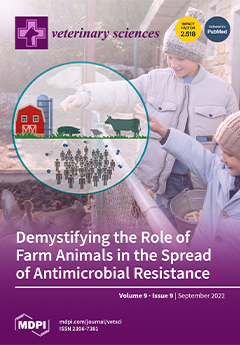The genus
Trichinella includes species with a wide geographical spread that cause pathology in humans and animals. In this context, an epidemiological study of
Trichinella infection was carried out in the northeastern part of Romania to investigate for the first time the prevalence
[...] Read more.
The genus
Trichinella includes species with a wide geographical spread that cause pathology in humans and animals. In this context, an epidemiological study of
Trichinella infection was carried out in the northeastern part of Romania to investigate for the first time the prevalence of this infection in pigs, horses, wild boars and bears, the geographical distribution of
Trichinella species and the natural reservoir of
Trichinella infection. Between 2010 and 2015, a total of 166,270 animals were examined by the method of artificial digestion, in order to calculate the annual and general prevalence of
Trichinella infection, according to the host and the
Trichinella species involved, the Pearson correlation coefficient (r), trendline and geographical distribution of species of the genus
Trichinella. Taxonomic framing was performed by the multiplex PCR method. The overall prevalence of
Trichinella infection in animals was 0.188%. Within the host species, the prevalence varied as follows: in pigs 0.096%, horses 0.021%, wild boar 1.46% and bears 36.76%. The geographical distribution showed that
T. spiralis was dominant, occupying the entire northeastern part of Romania, being identified in pigs, horses, wild boars and bears.
T britovi occupied five mountain counties, being identified only in wild boars and bears. These results validate the presence of
T. spiralis and
T. britovi in domestic and game animals in the northeastern part of Romania.
Full article






